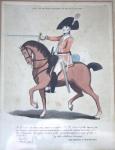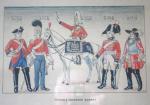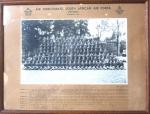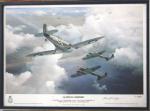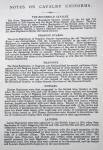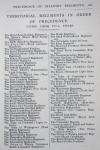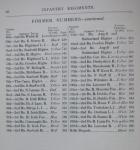-
Posts
13,225 -
Joined
-
Last visited
-
Days Won
22
Content Type
Profiles
Forums
Blogs
Gallery
Events
Store
Everything posted by Mervyn Mitton
-
Hi - Bob. I think Chris is right that this is a copy. The British Army issue knives are different. However, if it should turn out to be older and therefore contemporary with WW2 fighting - perhaps it is his record of 'incidents' . I often find 'count' marks on edged weapons and swords.................... Mervyn
-

ANTEDELUVIAN BUFFALOES
Mervyn Mitton replied to Mervyn Mitton's topic in Coins & Commemorative Medallions
Thankyou for that info Paul - should be useful in the future. What does GLE stand for ? Great Leader Enters ? Mervyn -
Hello Westernhighlander. Sorry your post has not been answered. These 'sun hats' were a peculiar pattern to South Africans and had the generic name of 'Polo Hats" The Army used them in brown and the airforce also, used this colour. I do not recall seeing a green issue. On our Medals section - the pinned post at the top a Lt.Col.- KIA during WW2, you will see that I show his ceremonial helmet - in white and with the very rare winged springbok top piece. The pattern was never popular and you rarely see them now - I had to pay Rands 2500 just for the shell in order to be able to display the Badge and other items. (approx. $250) There must be something on the internet for identifying the flashes - however, hopefully one of our South African members will be able to help. Mervyn
-

Abyssinian War Medal
Mervyn Mitton replied to a topic in Great Britain: Orders, Gallantry, Campaign Medals
Rick - do you think it is an award - or, was he just collecting miniatures ? I wasn't aware that any Germans would have been there ? -
http://gmic.co.uk/uploads/monthly_07_2013/post-6209-0-04782400-1372859512.jpgclick A little time ago, I showed a Military Cross Group - British and awarded in 1943 during the North African desert Campaign against the Afrika Korps. Since none were named - being British issue - we have been unable to place the recipient , however, these two pictures of the 1 st. King Dragoon Guards , were with the medals. During the 2nd World War they served as light armour in Scout cars and were in both the North Africa campaign and in Italy This modern drawing - seemingly done in the 1970's shows regimental dress in different periods.
-

Kandahar star medal
Mervyn Mitton replied to erichjr's topic in Great Britain: Orders, Gallantry, Campaign Medals
War and Son - welcome to GMIC. We are pleased to have you here and I am sure you will find us of interest and help. The Chairman does not allow advertising on the Forum and I will have to ask you to follow our format and leave out the details you are showing - also, we would prefer your Avatar not to be a business name. Having pointed out these details - which you were not to know - we will look forward to your joining in on suitable threads. Mervyn -
Jim - I have to say that I agree with Chris. We both can appreciate that you have a lot of knowledge and are a firearm collector - however, as Chris points out our Members have to adjust to the Forum. I will be sorry if you leave, but please do get used to our way of doing things. We have so many experts within our ranks that we stopped, long ago, trying to impress them. Mervyn
-

MARTINI HENRY RIFLE IN BOER USE
Mervyn Mitton replied to Mervyn Mitton's topic in Firearms & Ordnance
Hi - Jim. Yes, he was my old Supt. at Bethnal Green and is now Chairman of PICA - of which I am a member. (Police Insignia Collectors Assoc..) Some good info for the Gun enthusiasts - thankyou for posting. When I was at Geelong - in Aust .- our Cadet Force carried the martini cadet version. I suppose it was much lighter then the Lee Enfield. I expect we must have fired them, but I don't remember now. With regard to cartridges - when I first came to Sth. Africa from 1956-60 you could visit the site of the British Square at the last battle of the Zulu War - Ulundi - 1879. You could follow the exact outline of part of the Square by following the cartridge cases that had been trodden down. Now, of course, long sold to tourists. Mervyn -

My Early Police Days ....... Part 6
Mervyn Mitton commented on Mervyn Mitton's blog entry in Mervyn Mitton's Blog
This was the 'old' East End - believe me, there were plenty around........ -
Hi - Jim. Brian has already welcomed you to GMIC and as he says - we will look forward to seeing pictures and your future posts. Being a percussion cap revolver I think it falls outside of the requirements in the UK for licensing. However, the Forum covers most of the World and these same relaxations do not apply everywhere. South Africa took Flintlocks and percussion off of the register - now, they are thinking of putting multi-shot percussion back under license. Because of this - together with the fact that I am retiring (yet again !) at the end of August and closing the shop - I returned the gun in question to the original owner and have helped put it at auction. You say ' the owner brought it in.." Do you have a shop ? You must tell us a little about this - if I am correct ? Mervyn
-
INTRODUCTION I saw on TV that London has been subjected - yet again - to public disorder. I suppose a capital City will always be a target. Probably the worst riots that London ever saw were the Gordon Riots of 1780. Lord George Gordon stirred-up a great deal of sentiment about the Catholic Relief Act of 1778. This allowed Catholics to join the Army without taking the religious Oath. The British Army was short of men, being actively engaged in the United States War of Independence , plus other areas, this Act was intended to help recruiting. Demonstrations turned into violence and attacks on property and three prisons were broken into and the inmates allowed to escape. This made the situation even more violent and after three days the Guards and other Regiments were ordered onto the streets. Their order, discipline - and firepower brought things quickly under control. 285 rioters were killed. This was a lesson not quickly forgotten. http://gmic.co.uk/uploads/monthly_06_2013/blogentry-6209-0-37423900-1372082849.jpgclick GORDON RIOTS - painting by John Seymour Lucas During the Industrial Revolution - aprox. 1800's to 1850's - the Midlands and Northern Regions suffered from many outbreaks of violence and destruction. With really only the isolated local Constables, many Parishes swore in Special Constables from their citizens - often in the hundreds. They were usually equipped with a truncheon. http://gmic.co.uk/uploads/monthly_06_2013/blogentry-6209-0-47176800-1372083205.pngclick Peterloo Massacre - 1819 - by Richard Carlile When serious trouble occured and the Constables and Beadles lost control - the alternative was the Militia. The 16 August 1819 saw a very bad disturbence in Manchester - with many thousands in the crowd. The local authorities lost their nerves and ordered the Cavalry to charge. This became known as the infamous Peterloo Massacre - you cannot have a cavalry charge on men, women and children - mainly unarmed - without serious consequences. 15 were killed outright and between 400 and 700 maimed and injured. These two outbreaks of lawlessness - even though 40 years apart - caused the Government to think seriously on the reform of Policing in the Country and eventually the Home Secretary, Sir Robert Peel - with the backing of the Prime Minister , the Duke of Wellington and from the Lord Chancellor , the Lord Lyndhurst - introduced the Act which led to the formation of the Metropolitan Police and their going on duty in 1829. People often ask me how the Met. Police can be regarded as the first Civilian police force ? Dublin and Glasgow did pre-date the Met. - however, there were also numerous small towns who had formed Town Forces. Many of their truncheons still survive. However, none of these worked in the same way as London - or, with an Act of Parliament (apart from Dublin ). The organisation that was created to administer such a big area and with so many men, was a totally new concept. London and the Metropolitan Police can rightly be considered the first Civilian Police - and with it's distinctive style, was copied throughout Britain and very many other Countries - this also, included cities in the United States. London must still be the only City of it's size, where the greater majority of the Force do not carry firearms. For me, this must be a main criteria for a 'civilian force' - and, of course, this applies to most - if not all - of mainland Britain. Our Police are citizens of their communities and are probably the mainland defenders of our British way of life. GOODBYE HENDON Finally - week 13. We had exams to taken and - of course - all of the assessments made on us during the course were taken into account. I seem to remember that I came 2nd. or, 3rd. - really, it was not important - we had all come through together. http://gmic.co.uk/uploads/monthly_06_2013/blogentry-6209-0-24335500-1372085462.jpgclick Class Photo - I am 3rd.row - on right. We were issued with our truncheons and whistles at this point - to be followed with our Divisional numbers and Letters when we knew where we would be posted. We also had the class photo taken. The truncheon was 17 inches long (37cm), with a wrist strap at the end. Sewn into your trousers on the right side was a long pocket - this was behind the usual pocket. Most of our class could be seen - after issue - practising 'quick draws'. They looked like something out of the old 'wild west'. I was lucky to be issued with a dark coloured 'stick' - as they were called. Made from heavy lignum vitae - a South American wood - it probably dated back to the 1880's, as did my whistle. We had been asked to write down our Division of choice - however, it was explained that the final decision would be on which area needed replacements. Parts of the Met. area are quite rural - so, it is the Central Divs. that are preferred by most younger Constables. I had asked for 'B' Div. - that is the Knightsbridge area (Harrods !). I thought it would be interesting. What did I get - 'H' Division - London's East End. They nearly had my letter of resignation the same day............ Fortunately I didn't and it was a great place to work - always something happening. Epaulette insignia were now issued - they had to be on the uniform when you first went to the Divisional Station. Each letter and number had to be pushed through the cloth and then screwed-on - with so many jackets and coats it took forever. I expect they have a better way now ? I had become Police Constable 'H' 639. A number that was to become well known. I think my Course finished in Dec. 67 and I reported for duty early in January 1968. The acting Div. Station was Arbour Square Police Station - and it adjoined the famous Thames Magistrates Court. Commercial Street Station had been closed and the new Div. Station was being built at Leman Street. A very old street and a very old name. A Leman was the medieval word for a prostitute - very fitting.......... Leman Street has now been closed and my old station has been moved and is now the new Div. HQ.. Don't you just hate-it when you get old and everything keeps changing ! I think that there were three of us there that first morning - and the Chief Superintendent saw us separately - a very courteous thing to do. He explained that I was to be stationed at Bethnal Green Station - which was probably the heart of the East End. He also told me that I would have a room at Moylan House - Police section house - named after a former Commissioner. I was to be there for about eighteen months. 'H' Division was fairly small - approx. 2.5 miles x 2 miles (approx. 4 Kms x 3). Very denseley populated and at my time , still mostly 'cockneys'. Many have now moved to Essex and the 'Green' now has a very mixed population - with the famous Brick Lane area being mostly of Bangladashi descent. For my next 'thrilling' episode - Jack the Ripper - and, I meet Reggie and Ronnie - the infamous Kray twins. http://gmic.co.uk/uploads/monthly_06_2013/blogentry-6209-0-02187400-1372088014.jpgclick My original epaulettes for 'shirtsleeve order'



